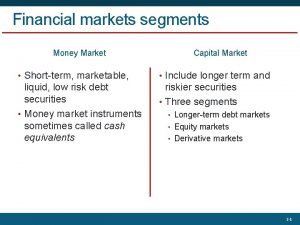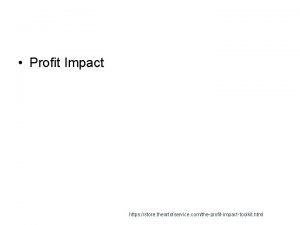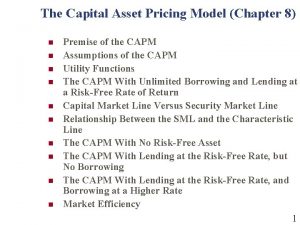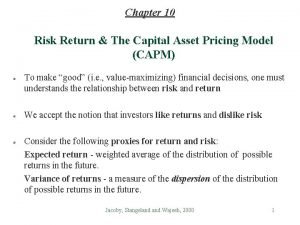THE IMPACT OF PRIVATIZATION ON CAPITAL MARKET DEVELOPMENT
































- Slides: 32

THE IMPACT OF PRIVATIZATION ON CAPITAL MARKET DEVELOPMENT AND INDIVIDUAL SHARE OWNERSHIP Presented by: William L. Megginson Professor & Rainbolt Chair In Finance The University of Oklahoma USA wmegginson@ou. edu http: //faculty-staff. ou. edu/M/William. L. Megginson-1

3 rd FIBV GLOBAL EMERGING MARKETS CONFERENCE & EXHIBITION Istanbul Convention & Exhibition Center April 5 -7, 2000

13 th MEETING OF THE OECD ADVISORY GROUP ON PRIVATISATION (AGP) Organization of Economic Cooperation and Development Paris, France September 22 -23, 1999

Talk Will Focus On Four Key Aspects of Privatization & Capital Market Development • Will First Examine Whether Capital Markets Are Prospering Relative To Commercial Banks In Financing Corporations – Markets Have Prospered; Banks Have Stagnated Since 1990 • Then Document Role Of Share Issue Privatizations (SIPs) In Stock Market Development Since 1983 – SIPs The Largest Capitalization Stocks & Largest Offerings • Ask Whether SIP Investors Have Earned Positive Excess Returns Over Short & Long-Run Holding Periods – Research Finds That Investors Have Done Very Well • Conclude By Examining Privatization’s Impact on Individual and Institutional Shareholdings – Has Revolutionized Share Ownership In All Non-US Markets

Part I: The Rise Of Capital Market Finance • The (Stable) Role Of Commercial Banks In Modern Economies • The Rapid Growth In Stock Market Capitalization And Trading Volume Since 1983 • The Dramatic Surge In Securities Issuance Volume Since 1990 • The Surge In Mergers And Acquisitions Worldwide

Domestic Credit Provided By The Banking Sector As A Percent of GDP, 1990 vs 1998

The One Growth Area In Banking: Syndicated Lending

World Stock Market Capitalization, 1983 -98 $US Trillion

The Growth Of World Stock Market Trading Volume, 1983 -1998 (Value Traded $Billion)

Capital Markets Have Grown Enormously-Both Absolutely & As Percent Of GDP

Value (In $US Billion) Of Worldwide And U. S. Security Issues In 1999 Versus 1990

Total Value Of Announced U. S. Mergers And Acquisitions, 1990 -1999 ($US Billions)

Part II: Privatization’s Impact On Stock And Bond Market Development • Total Proceeds Raised By Privatization Programs Since 1977 • Privatization’s Impact On Non-U. S. Stock Market Capitalization And Trading Volumes • Privatization’s Impact On International Investment Banking Practices

Annual Privatization Revenues For Divesting Governments, 1988 -1999 ($US Billions)

Privatization’s Success Has Become Critical For Many Divesting Governments • Cumulative Value Of Privatization Revenues Received By Governments Exceeded $1 Trillion In 1999 – Money Retained By Government, So Success Very Important – Most Proceeds From Share Issue Privatizations (SIPs) • SIP Programs Designed To Attract & Favor Domestic Investors--Most Of Whom Are First-Time Investors – Favor Citizens To Promote Reform, Win Votes – Study Examines Offering Terms In SIPs – SIPs Protect Citizens’ Interest Better Than Voucher Schemes • Large-Scale SIP Program Drastically Increases Stock Market Capitalization & Liquidity And Number Of Individual S/Hs – Leads To Demand For Effective Securities Laws, Regulation – Initially Create Many Individual S/Hs; Later Institutional S/Hs

Research Documenting Importance Of Capital Market Development & Privatization • Researchers Have Documented Direct Relationship Between Size Of Capital Markets And Economic Growth – Levine (JEL 97), Levine & Zervos (AER 98), Demirguc-Kunt & Maksimovic (JF 98), Rajan & Zingales (AER 98) – Vast Literature On Merits Of Banks Vs Capital Markets • Growing Literature Showing Superiority Of Private Vs State Ownership; Performance Improvements In Privatization – Ownership: Boardman & Vining (JLE 89); Dewenter & Malatesta (AER 2000) – Privatization: Megginson, Nash, and Randenborgh (JF 94), Boubakri & Cosset (JF 98); D’Souza & Megginson (JF 99)

Privatization’s Impact On Stock Market Capitalization • Total World Market Cap Rose From $3. 38 Trillion In 1983 To $26. 5 Trillion In 1998, $38. 7 Trillion in 1999 – Market Cap Of SIPs Rose From <$50 Billion To $2. 44 Trillion • 84 of 1999 Business Week Global 1000 Are SIPs – SIPs 10% Of Total, 21% Of Non-US Market Cap • 49 of BW Top 200 Emerging Markets Firms SIPs – Five Largest--And 7 Of 8 Largest--Firms All SIPs • Under-states True Importance Of SIPs – Play Very Important “Bellweather” Role • SIPs Usually A Country’s Largest Cap Firm – Also Most Actively Traded--Usually By Wide Margin

SIPs Often The First, Second, And/Or Third Most Valuable In A Nation’s Stock Market

Market Value & Market Capitalization of Privatized Firms (BW Global 1000)

Market Value & Country Rank of Privatized Firms (Emerging Markets)

Privatizations As Equity Issues • 25 Largest Share Offerings Are All SIPs – 35 0 f 39 Largest Are SIPs • 29 SIPs Larger Than $5. 5 bn UPS IPO (Nov 99) • 750+ SIPs Have Raised > $700 bn Since 1977 • 125 SIPs Have Raised More Than $1 bn • Differences From Private-Sector Issues: – Typically Pure Secondary Offerings – Highly Politicized Offer Terms & Share Allocations • SIPs Almost Always Nation’s Largest Share Issue – True For Every Major Country Except U. S.

The Largest Share Offerings In Financial History Are All SIPs

Part III: The Initial And Long Term Return To Investors In SIP Programs • Initial (First Day) Returns To Investors In Share Issue Privatization (SIP) Programs • Long Term (1, 3, And 5 -Year) Excess Returns Earned By Investors In SIP Programs

Academic Studies Documenting Significant Underpricing of Privatization IPOs (PIPOs) • • Menyah & Paudyal (1996): 40 British PIPOs Dewenter & Malatesta (1997): 109 Firms From 8 Countries Huang & Levich (1998): 507 SIPs From 39 Countries Paugyal, Saadouni & Briston (1998): 18 Malaysian PIPOs Jones, et al. (1999): 630 SIPs, 59 countries Su & Fleisher (1999): 308 Chinese PIPOs, 940% Return Jelic & Briston (2000): 25 Hungarian PIPOs Choi & Nam (2000): 185 PIPOs From 30 Countries

How Politicized Are Pricing & Share Allocation Terms In SIPs? • Governments Have Learned How to Achieve Political And Economic Objectives In SIP Programs – Balance Revenue Maximization Vs. Political Objectives • Jones, Megginson, Nash & Netter (JFE 99) Test Perotti (AER 95), Biais & Perotti (WP 97) Models: – Find SIPs Significantly & Deliberately Underpriced – Govts Almost Always Choose Fixed Price Offers – Allocate Shares To Citizens, SOE Employees – Govts Almost Never Sell 100%, Rarely Sell Control – Often Have Control Restrictions (“Golden Share”) – IR Directly Related To % Capital Offered, Gini Coeff – IR Negatively Related To Govt’s “Populism” – IR Not Significantly Related To Firm Size (Not AI)

Academic Studies Documenting Significant Positive Long-Run Excess Returns For SIPs • • • Levis (1993): 12 British PIPOs Menyah, Paudyal & Inganyete (1995): 40 British PIPOs Paudyal, Saadouni & Briston (1998): 18 Malaysian PIPOs Boubakri & Cosset (1999): 126 SIPs, 26 Developing Nations Jelic & Briston (2000): 25 Hungarian PIPOs Perotti & Oijen (2000): 22 Developing Countries Choi, Nam & Ryu (2000): 204 PIPOs From 37 Countries Megginson, et al. (2000): 158 PIPOs From 33 Countries Dewenter & Malatesta (2000): 102 Large SIPs Boardman & Laurin (2000): 99 SIPs, Multiple Countries

Part IV: The Impact Of Privatization On Individual & Institutional Shareholdings • The Impact Of Privatization Programs on Individual Share Ownership • The Impact Of SIP Programs on Institutional Ownership Of Privatized Firm Shares

Share Issue Privatization And Individual Stock Ownership • Many Governments Try To Create “Equity Culture” – Design Offer Terms To Maximize Number Of Individual S/Hs – Allocate Shares To Favor Citizens Over Foreigners, Encourage Individual Ownership • Large SIPs Often Create 1 Million+ Shareholders – France Telecom 3. 9 Mn, Deutsche Telecom 3 Mn, Credit Lyonnais 3. 4 Mn, Telecom Italia 2 Mn+, Endesa 2 Mn+ – New S/Hs Often Own Shares In Only One Company • Must Create A Governance System That Protects S/Hs – Democratic Governments Very Sensitive To Small S/H Losses – Major Problem In CEE--Especially Russia

Share Issue Privatization And Individual Stock Ownership (Continued) • Boutchkova & Megginson (Current Study) Compare Number Of Shareholders In SIPs To Those In Private Firms With Closest Market Capitalization – World. Scope Disclosure: 6, 400 Firms With # S/Hs – Number Of S/Hs Highly Skewed: <2% Of All Firms Have >250, 000 S/Hs; 915 Have <50, 0000 – 55 Of 89 Non-U. S. Firms 500, 000+ S/Hs Are SIPs – SIPs Have Significantly Larger # Of S/Hs Than Private Firms • Key Finding: Large Numbers Of S/Hs Not Stable – Firms With 250, 000+ Initial S/Hs Decline By 20% In 6 Years • Apparently Individuals Sell To Institutional Investors – Foreign Investors Now Own Half Of Many European SIPs – May Help Over Time To Create Funded Pension System

Relative Number of Shareholders Over A Six Year Period After A Share Issue Privatization 1. 6 1. 4 <100, 000 1. 2 1 All 1 0. 8 >100, 000 >500, 000 0. 6 >250, 000 0. 4 Year 0 Year +1 Year +2 Year +3 Year +4 Year +5 Year +6 0. 6

Relative Number of Shareholders Of Non. Privatized Companies Over A 9 Year Period 1. 6 <100, 000 1. 4 All 1. 6 1. 4 1. 2 >100, 000 1 1 >250, 000 0. 8 0. 6 0. 4 Year 0 Year +1 Year +2 Year +3 Year +4 Year +5 Year +6 Year +7 Year +8 Year +9 0. 8

Summary & Conclusions • Capital Markets--Especially Stock Markets--Are “Winning” The Battle To Dominate Corporate Finance – Market Cap, Trading Volume Tripled During 1990 s – Volume Of Securities Issuance Up Six-Fold • Privatizations Have Played Key Role In Stock Market Growth – Usually Largest Cap Stocks, Always Largest Share Issues • Investors In SIPs Have Benefited In Short & Long Run – PIPOs Deliberately Underpriced; High Initial Return & – Significantly Positive Long-Run Excess Returns (1, 3, 5 -Yr) • Privatizations Have Dramatically Increased Number Of Individual Investors In Non-US Markets – Very Large Number Of S/Hs Not A Stable Ownership Pattern • Future Looks Very Bright For Stock Markets & Privatization
 Advantages of privatization
Advantages of privatization Privatization of water
Privatization of water Wkstra
Wkstra Capital allocation line vs capital market line
Capital allocation line vs capital market line Segments of money market
Segments of money market Importance of money market
Importance of money market Capital market development authority
Capital market development authority Market leader follower challenger nicher
Market leader follower challenger nicher Steps in market segmentation targeting and positioning
Steps in market segmentation targeting and positioning Profit impact of market strategy pims model
Profit impact of market strategy pims model Labour market impact assessment lmia online web application
Labour market impact assessment lmia online web application Gross operating cycle
Gross operating cycle Difference between capital reserve and reserve capital
Difference between capital reserve and reserve capital Multinational cost of capital and capital structure
Multinational cost of capital and capital structure Difference between capital reserve and reserve capital
Difference between capital reserve and reserve capital Basle ii
Basle ii Regulatory capital vs economic capital
Regulatory capital vs economic capital Constant and variable capital
Constant and variable capital Multinational cost of capital and capital structure
Multinational cost of capital and capital structure Low impact development
Low impact development Low impact development
Low impact development Capital market line
Capital market line Capital market line
Capital market line Homemade leverage upsc
Homemade leverage upsc Portfolio weights
Portfolio weights Capital market line
Capital market line Structure of indian capital market
Structure of indian capital market Importance of capital market
Importance of capital market Cost efficient capital market
Cost efficient capital market Capital market authority egypt
Capital market authority egypt Yang fin
Yang fin Market risk
Market risk Capital structure in a perfect market
Capital structure in a perfect market























































